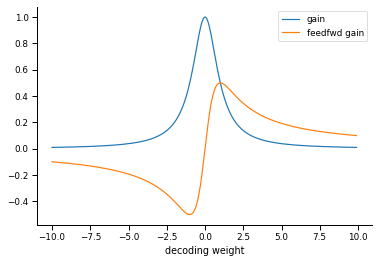Adaptive recurrent spiking autoencoder
Python implementation of adaptive spiking neural net proposed in Gutierrez and Deneve eLife 2019.
Recurrent spiking autoencoder with adaptation
Gutierrez and Denève, “Population adaptation in efficient balanced networks”. eLife, 2019.
This eLife paper derives a spiking auto-encoding RNN from a simple quadratic objective.
At any given moment, the rate, \(r\), of each neuron can be read out via a decoding weight \(w\) to reconstruct the input stimulus \(\phi\) as \(\hat{\phi}\),
\[\hat{\boldsymbol{\phi}}(t)=\sum_{i} w_{i} r_{i}(t).\]The TLDR is that the network greedily optimizes the objective \(E\) input reconstruction + L2 rate history regularizer,
\[E(t) = (\phi(t) -\hat{\phi}(t))^2 + \mu \parallel f(t) \parallel_2^2\]where \(f(t)\) is a low-pass history filter on rates of a neuron, and \(\mu\) is a constant. It’s greedy because only one neuron spikes at a time, meaning similarly-tuned neurons will effectively be competing with and inhibiting each other. The results rest on the assumption that there is some decoder whose weights \(w\) fully determine the network’s encoding and recurrent weights in conjunction with the rate penalty \(\mu\).
import numpy as np
import matplotlib.pyplot as plt
import seaborn as sns
from tqdm.auto import tqdm
Simulation set-up
We’re going to have a 2D input representing some oriented input theta, and 200 neurons with uniformly-distributed tuning preference for orientation.
The stimulus over time will be phi, and its time derivative is dphi.
There are two neurons tuned to each unique orientation theta – one with high gain and one with low gain.
I construct the weight matrix W, gains matrix G, and phi and dphi below, and set the time constants for the sim.
# time
dt = 1 # units: msec
time = np.arange(0, 3.5E3+dt, dt)
# params
nj = 2 # input dim
nn = 200 # n neurons
tau = 5 # shorter tau --> more variance in estimate, recruits more neurons
tau_a = 2000
mu = .1
sgain = 50
stime = np.arange(.5E3//dt, 3.5E3//dt, dtype=int)
# connectivity
nw = nn//2
theta = np.arange(0, 2*np.pi, 2*np.pi/nw)
theta = np.stack([theta, theta], 1)
theta = np.reshape(theta, -1)
bgain1, bgain2 = (3., 9) # (3, 9)
bgain = np.tile([bgain1, bgain2], nw)
W = np.stack([np.cos(theta) * bgain, np.sin(theta) * bgain])
Gain = np.diag(np.diag(2./(W.T@W + mu)))
thresh = 1
eta = 10. # linear cost factor
# noise and inputs
pp = 18 # increase this to increase the resolution of the transfer functions
thetp = np.arange(0, 2*np.pi, 2*np.pi/pp)
phi = np.zeros((nj, len(time)))
test_thet = thetp[8] # which ori to plot
phi[0,stime] = np.cos(test_thet) * sgain
phi[1,stime] = np.sin(test_thet) * sgain
dphi = np.hstack([np.zeros((nj,1)), np.diff(phi,1,1)]) # if s has extra dims
fig, ax = plt.subplots(2,1, sharex="all", sharey="all")
ax[0].plot(phi.T)
ax[1].plot(dphi.T);
ax[0].set(ylabel=r"$\phi$", title="input and input derivative")
ax[1].set(xlabel="time", ylabel=r"$d{\phi}/dt$")
sns.despine()
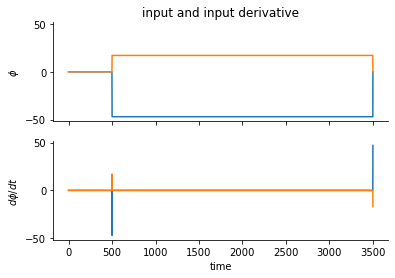
Simulate w/ Euler iteration
The voltage dynamics are given by
\[\tau \dot{V}_{i}=-V_{i}+g_{i} w_{i}(\tau \dot{\phi}+\phi)-\tau g_{i} \sum_{j} \Omega_{i j} o_{j} - \kappa_{i} f_{i}.\]where the taus are time constants, and \(\kappa_{i}=\mu g_{i}\left(1-\frac{\tau}{\tau_{a}}\right)\). What is interesting is the lack of an explicit \(\hat{\phi}\) reconstruction term. There is a \(\dot{\phi}\) (dot) term, implying a neuron must receive both the stimulus input as well as the stimulus time-derivative. This dynamical system means that each neuron’s voltage has an additional leak term (last term) that is dependent on its own spiking history. Another way to think about this (and how it is implemented in the simulation) is that its spiking threshold is dynamically changing.
The other terms are defined below. The rate is given by a low-pass over recent spiking output \(o(t)\)
\[\dot{r}_{i}=-\frac{1}{\tau} r_{i}+o_{i}\]The subtractive adaptation signal \(f\) is the spike history over a long time window.
\[\dot{f}_{i}=-\frac{1}{\tau_{a}} f_{i}+o_{i}\]The gain of each neuron \(i\) is determined by the regularization constant and the decoding weights.
\[g_{i} = 1 /\left(w_{i}^{2}+\mu\right)\]The lateral recurrent weights are also determined by the decoding weights and regularization constant.
\[\Omega_{i j}=w_{i} w_{j}+\mu \delta_{i j}\]All the following time-varying variables are simulated:
v: varying voltageo: spiking outputr: rate (short time constant low-pass filter on spike count)f: rate history (long time constant low-pass filter on spike count)phi_hat: estimated reconstructed input given the network spikes at any given moment
# init
o = np.zeros((nn, len(time)))
r = np.zeros((nn, len(time)))
f = np.zeros((nn, len(time)))
v = np.zeros((nn, len(time)))
phi_hat = np.zeros((nj, len(time)))
# input is a function of phi and dphi, as well as ofc the weights and gains
feedfwd = Gain @ W.T @ (phi + tau * dphi)
Omega = W.T @ W + np.eye(nn)*mu # recurrent weights
Kappa = ((tau/tau_a)-1)*mu*Gain # adaptation term, like an extra leak term
fig, ax = plt.subplots(1,2,sharex="all", sharey="all", figsize=(8,4), dpi=150)
sns.heatmap(Omega, ax=ax[0], square=True, cmap="icefire")
sns.heatmap(Gain, ax=ax[1], square=True)
ax[0].set(xticklabels=[], yticklabels=[], xlabel="neuron", ylabel="neuron", title="recurrent weights \n $\Omega=W^T W + \mu I$")
ax[1].set(xticklabels=[], yticklabels=[], xlabel="neuron", ylabel="neuron", title="Gain matrix");
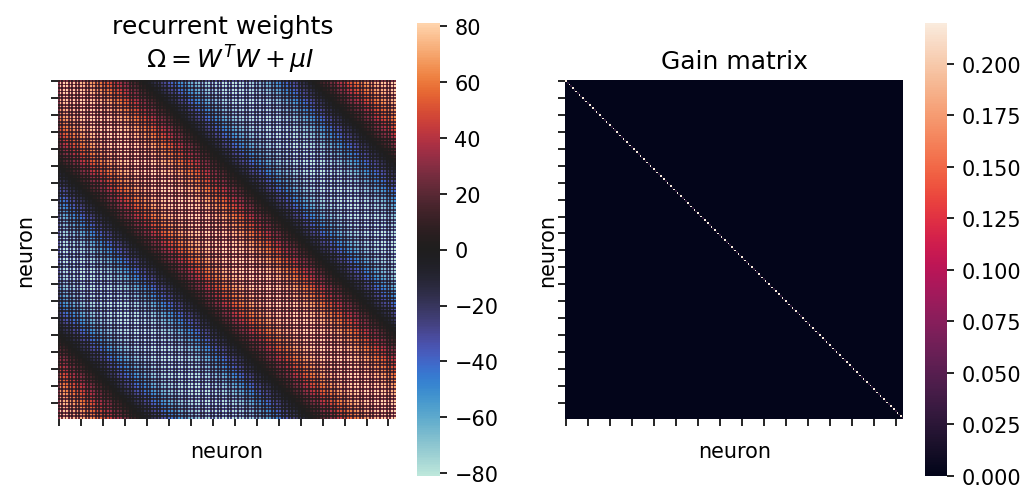
Run simulation
pbar = tqdm(range(len(time)))
for t in pbar:
# voltage dynamics
dvdt = -v[:,t-1] + feedfwd[:,t-1] - tau*Gain@Omega@O[:,t-1] + Kappa@f[:,t-1]
v[:,t] = v[:,t-1] + dt * (dvdt/tau)
# adaptive threshold and binary spiking output
adaptive_thresh = thresh + eta*np.diag(Gain)
o[:,t] = (v[:,t] >= adaptive_thresh)/dt # threshold crossing neurons spike
# greedy spiking -- only allow argmax(voltage-adaptive_thresh) to fire suppress remaining neurons
if o[:,t].sum() > 1/dt:
vi = np.argmax(v[:,t] - adaptive_thresh) # determine winner neuron
o[:,t] = 0 # suppress all
o[vi,t] = 1/dt # allow only 1 to spike
# rate dynamics
dr = -(1/tau) * r[:,t-1] + o[:,t-1]
r[:,t] = r[:,t-1] + dt*dr
# rate history dynamics (much longer timescale tau_a >> tau)
df = - (1/tau_a) * f[:,t-1] + o[:,t-1]
f[:,t] = f[:,t-1] + dt*df
# decoder, i.e. reconstructed stimulus dynamics
dphi_hat = -(1/tau) * phi_hat[:,t-1] + W@o[:,t-1]
phi_hat[:,t] = phi_hat[:,t-1] + dt*dphi_hat
Plot simulation
def maxmin(x):
return np.max(np.squeeze(np.abs(x)))
fig, ax = plt.subplots(5, 1, dpi=150, sharex="all", figsize=(10,15))
sns.heatmap(feedfwd, cmap="icefire", vmin=-maxmin(feedfwd), vmax=maxmin(feedfwd),rasterized=True, ax=ax[0], cbar_kws={"label": "feedfwd drive"})
sns.heatmap(v, cmap="icefire", vmin=-maxmin(v), vmax=maxmin(v), rasterized=True, ax=ax[1], cbar_kws={"label": "voltage"})
sns.heatmap(o, cmap=[(0,0,0), (.9,.9,.9)], rasterized=True, ax=ax[2], cbar_kws={"ticks": (0,1), "label": "spike"})
sns.heatmap(r, cmap="rocket", vmin=0, vmax=maxmin(r), rasterized=True, ax=ax[3], cbar_kws={"label": "rate"})
sns.heatmap(f, cmap="rocket", vmin=0, vmax=maxmin(f), rasterized=True, ax=ax[4], cbar_kws={"label": "integrated rate history"})
ax[0].set(ylabel="neuron", yticks=[])
ax[1].set(ylabel="neuron", yticks=[])
ax[2].set(ylabel="neuron", yticks=[])
ax[3].set(ylabel="neuron", yticks=[])
ax[4].set(xticks=[], xlabel="time", ylabel="neuron", yticks=[]);
fig.tight_layout()

What does the 2D input and reconstructed output look like?
fig, ax = plt.subplots(2,1, sharex="all", sharey="all", dpi=150)
abs_peak = np.max(np.abs(np.concatenate([np.squeeze(phi), np.squeeze(phi_hat)])))
sns.heatmap(phi, vmin=-abs_peak, vmax=abs_peak, ax=ax[0])
sns.heatmap(phi_hat, vmin=-abs_peak, vmax=abs_peak, ax=ax[1])
ax[0].set(ylabel="stimulus input")
ax[1].set(xticks=[], xlabel="time", ylabel="reconstructed stimulus", yticklabels=[r"$\phi_0$", r"$\phi_1$"]);
fig, ax = plt.subplots(1,1)
ax.hlines(thetp[8], 0, 3500, "r", linestyle="--")
ax.scatter(range(len(phi_hat[0])), np.mod(np.arctan2(phi_hat[1], phi_hat[0]), np.pi), s=1)
ax.set(xlabel="time", ylabel="orientation (rad)")
sns.despine()
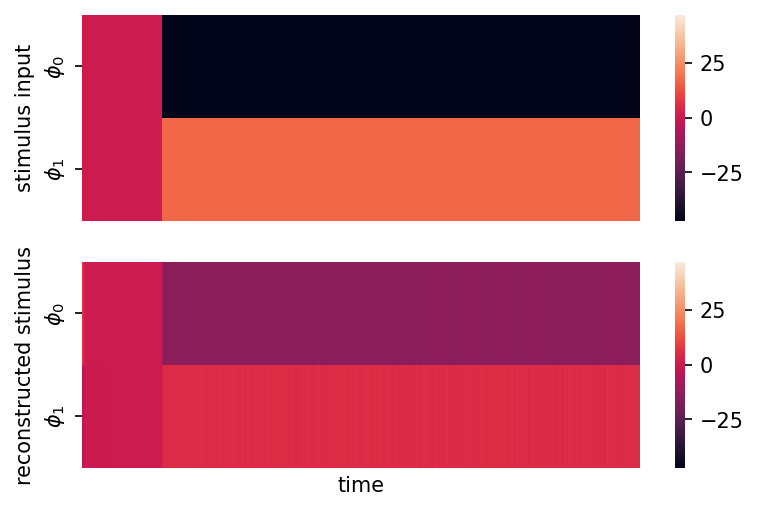
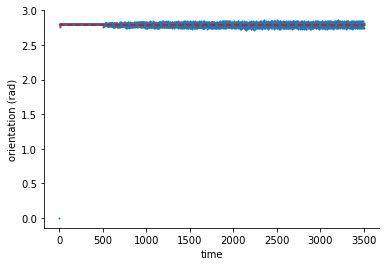
Relationship between neuron gain and decoding weight
What the authors call the gain of each neuron is determined by their decoding weight. Small decoding weights are associated with high-gain neurons, and large decoding weights are associated with low-gain neurons.
W2 = np.arange(-10, 10, .1)
mu2 = 1
gain = 1 / (W2*W2 + mu2)
gain_feedfwd = W2 / (W2*W2 + mu2)
with sns.plotting_context("paper"):
fig, ax = plt.subplots(1, 1)
ax.plot(W2, gain, label="gain")
ax.plot(W2, gain_feedfwd, label="feedfwd gain")
ax.set(xlabel="decoding weight")
ax.legend()
sns.despine()
